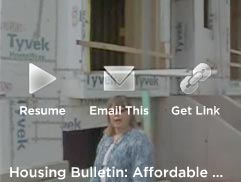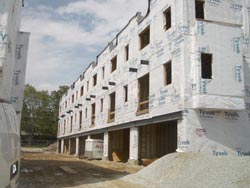Walk through the construction site and see how Highland Park is building affordable, green housing.
|
|
|
|
In Highland Park, where the average home sale price is $769,000, there is a development of ten townhouses being built right now with price tags ranging from $165,000 to $239,000. The complex, which will also have four rental apartments and several important green features, is a good example of what can happen when a municipal government throws its weight behind the idea that the people who work in a town ought to be able to afford to live there.
Sales of the townhouses at 500 Hyacinth Place began last month, and three are already spoken for (their sales won’t close until construction is completed later this year). The primary target market is the town’s school, police, fire, library, and parks workers; one of the first buyers was a Spanish teacher in the Highland Park schools.
The townhouses have a spacious three-bedroom layout on three levels, not counting the garage, and will feature attractive contemporary styling outside (in other words, they won’t look like anything less than a good addition to the neighborhood). A wind turbine that generates electricity to power all common-area lighting will sit atop one of the complex’s three buildings. The rest of the roofing is highly reflective, to cut down on heat absorption, and the structures will have energy efficient walls and windows. Native plants needing little water are planned for outside, and there will be sustainably grown bamboo flooring inside.
The most exciting of the green touches is the geothermal heating/cooling system, the first I know of in a suburban multifamily development. Geothermal systems rely on the steady temperature below ground to help cool homes in the summer and heat them in the winter, dramatically reducing the use of air conditioners and furnaces.
“This is my poster child for affordable housing,” Mary Ellen Tamasy said at a recent Metropolitan Planning Council luncheon, where she presented the Hyacinth Place project as a potential model for other communities. Tamasy is the executive director of Housing Opportunity Development Corp., a not-for-profit agency that is a partner on 500 Hyacinth Place with Brinshore Development, a for-profit company that has also built senior housing in Highland Park and replacement housing for the Chicago Housing Authority in Bronzeville and Westhaven Park (the latter site is near the United Center).
Currently under construction at the north end of Highland Park (on a parcel of land that was formerly zoned for business), Hyacinth Place is across the street from a Metra station and adjacent to a very nice residential neighborhood. The city obtained the land, valued at about $2 million, a few years ago in a swap, giving a comparable parcel at the center of town to a health agency that wanted to build a new facility there. The city then donated the parcel to the Hyacinth developers.
That $2-million contribution from the city went a long way toward bringing the prices of the homes down: if the developers had paid market value for the land, each of the 14 townhouses and apartments would have cost almost $143,000 more. But that’s not all the city kicked in. Waived fees and an outright grant from the city totaled about another $650,000, according to Rob Anthony, the head of the Highland Park Community Land Trust, which will own the land beneath 500 Hyacinth Place. Mary Ellen Tamasy says that other agencies and governments made grants for the green features, which are expensive up front but hold down residents’ energy costs over the long term.
Data from Midwest Real Estate Data shows that, in the past 12 months, just nine of the 270 houses, townhouses, and condos sold in Highland Park were within or lower than the Hyacinth Place price range. Tamasy says that the townhouses have been valued at around $400,000, but the land trust will ensure that, in the future, the residences will be resold at affordable prices. “In exchange for paying 20 to 65 percent below the market value, you agree to sell it at a lower price when you go to sell the home,” Anthony says. And Tamasy says there is talk among several other North Shore towns of creating a regional trust fund to help low-paid local workers find affordable housing in their communities.
 In Highland Park, where the average home sale price is $769,000, there is a development of ten townhouses being built right now with price tags ranging from $165,000 to $239,000. The complex, which will also have four rental apartments and several important green features, is a good example of what can happen when a municipal government throws its ...
" />
In Highland Park, where the average home sale price is $769,000, there is a development of ten townhouses being built right now with price tags ranging from $165,000 to $239,000. The complex, which will also have four rental apartments and several important green features, is a good example of what can happen when a municipal government throws its ...
" />





